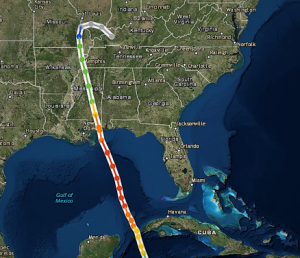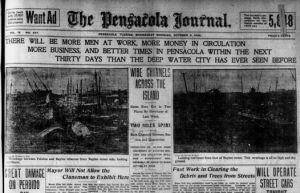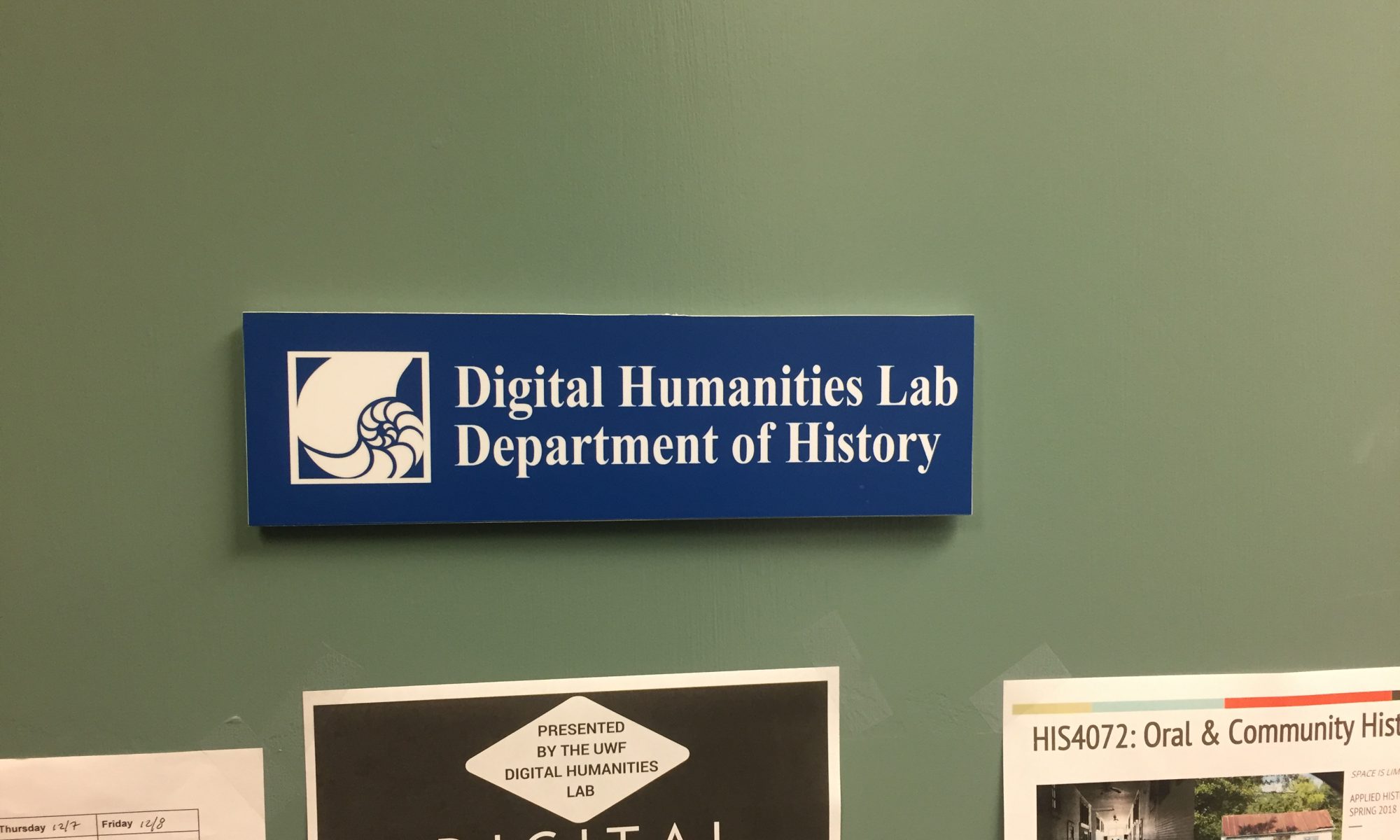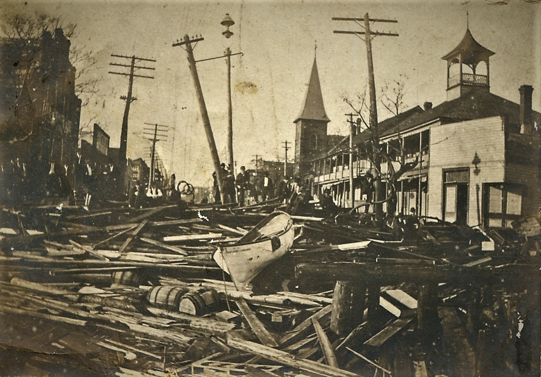
Hurricanes introduced both challenges and opportunities to the shaping of Pensacola. On September 19, 1906, a tropical system emerged in the Gulf of Mexico which soon developed into a Category 3 hurricane with maximum sustained winds of 105 mph and a 952 millibar intensity. The system churned through the Gulf making landfall on September 27, 1906 as a Category 2 hurricane in Pascagoula, Mississippi with maximum sustained winds of 95 mph. The impact of this system on Escambia County proved enormous. The devastating winds and storm surge destroyed structures along the waterfront, disrupting the city, and inspiring the community to come together to recover both physically and economically.
Newspapers in 1906 compared this event to the Great Galveston Hurricane of 1900. To thwart economic uncertainty, city managers prompted citizens to participate in a massive clean-up effort. Initial damage assessments of the area surrounding Santa Rosa Island included most structures within Fort Barrancas, the Life Saving Station, Pensacola Navy Yard, and The Pensacola Journal reported that Fort McRae became completely razed. At Fort Pickens,

L. M. Shaw, Secretary of the Treasury, reported a storm surge 10 feet above normal. Damage included flooding to most of the batteries, wharf, and fire-control stations. The Chief of Engineers submitted damage estimates to Shaw of $22,100. Shaw revised this estimate to Congress, due to a reassessment submitted by William H. Taft, Secretary of War. A December 22, 1906 correspondence from Taft included the urgent matter of building a sea wall of sufficient height and width to sustain impact from events of this nature and protect lives within the fort. The new repair estimate submitted for Fort Pickens with Fort McRae became $907,100.

Within the city of Pensacola many wharfs required extensive repairs to structures, loading mechanisms, and railroad tracks. The Muscogee Wharf broke in two, while several other wharfs sustained severe damaged. Railroads tracks running from the waterfront and through Pensacola reported severe damage including thirty-nine freight cars which washed away into the raging waters. The storm partially destroyed the Escambia Bay Bridge and the Pensacola waterfront sustained major flooding. The Hurricane of 1906 destroyed physical assets, yet, injected money into the area for recovery. For Pensacola, this money translated into improvement rhetoric. Following the Hurricane of 1906, the Chamber of Commerce Secretary, W. C. Jones, mailed a statement of confidence to tourist who visited Pensacola emphasizing the area’s resilience.
Recommended Readings
Garriott, E. B. “The West Indian Hurricane of September 1906.” Monthly Weather Review, NOAA. Department of Commerce. September 1906. Accessed February 2, 2017. http://www.aoml.noaa.gov/hrd/hurdat/mwr_pdf/1906.pdf
Shaw, L. M. “Sea walls at Pensacola Harbor, Florida. Letter from the Secretary of the Treasury, transmitting a copy of a communication from the Secretary of War submitting an estimate of appropriations for defenses at Pensacola.” January 3, 1907. Serial Set Volume Number 5154, Session Volume Number 51. U.S. Congressional Serial Set 59th Congress House, 2nd Session. H. Document 360. U.S. Department of the Treasury. U.S. Accessed April 10, 2017. http://infoweb.newsbank.com.ezproxy.lib.uwf.edu/iw-search/we/Digital/?p_product=SERIAL&p_theme=sset2&p_nbid=F57T45SAMTQ5Mjg3NzY3My40MDQwNzQ6MToxMjoxNDMuODguNjYuNjY&p_action=doc&p_docnum=6&p_queryname=3&p_docref=v2:0FD2A62D41CEB699@SERIAL-1174D0151282E058@-@0
Jones, W. C. “Pensacola and the September Hurricane: Subject of a Pamphlet Issued by Secretary W. C. Jones, of the Chamber of Commerce Which is Being Mailed to Many.” Pensacola Journal. 8. November 2, 1906. Accessed March 1, 2017. http://pnj.newspapers.com/image/80961952/
Featured Image:
Burrow, John. “1906 Hurricane, Pensacola, Florida: Foot of Palafox Street Looking North, Hurricane Damage.” September 27, 1906. Image. Burrow Press. Dorothy Burrow Papers. University Archives. West Florida History Center. UWF Libraries. http://librarydigitalservices.uwf.edu/Archon/index.php?p=digitallibrary/digitalcontent&id=2189
Author: Diana Ritzie
ORCID ID: 0000-0001-6678-3157

